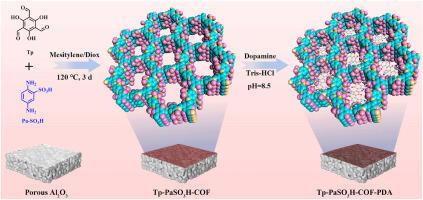Electrostatic-driven dopamine confined covalent organic frameworks membrane for enhancing hydrogen separation
IF 9
1区 工程技术
Q1 ENGINEERING, CHEMICAL
引用次数: 0
Abstract
Two-dimensional covalent organic frameworks (2D COFs) demonstrate significant potential for gas separation due to their crystalline nanochannels and structural tunability, yet practical implementation is constrained by inherent pore size limitations (>0.8 nm) and processing challenges. Herein, we engineered a Tp-PaSO3H–COF-PDA composite membrane through an electrostatic-driven infusion of dopamine (DA) into solvothermally synthesized Tp-PaSO3H–COF channels on α-Al2O3 supports. The resulting composite membranes own dual-function separation mechanisms. Pore size reduction enhances molecular sieving capabilities, resulting in an improvement in the separation performance of H2/N2 and H2/CH4. Concurrently, amino-rich polydopamine (PDA) networks provide specific CO2 affinity sites that selectively hinder CO2 transport, leading to further improved H2/CO2 separation performance. The membrane demonstrates operational stability under varying transmembrane pressures, feed compositions, temperatures, and extended operation. This confinement strategy transforms conventional covalent organic frameworks into precision separation platforms for sustainable hydrogen purification.

静电驱动多巴胺约束共价有机框架膜增强氢分离
二维共价有机框架(2D COFs)由于其晶体纳米通道和结构可调性而显示出巨大的气体分离潜力,但实际实施受到固有孔径限制(>0.8 nm)和加工挑战的限制。在此,我们通过在α-Al2O3载体上的溶剂热合成的Tp-PaSO3H-COF通道中注入多巴胺(DA),设计了Tp-PaSO3H-COF - pda复合膜。所得到的复合膜具有双重功能分离机制。孔径的减小提高了分子筛分能力,从而提高了H2/N2和H2/CH4的分离性能。同时,富氨基聚多巴胺(PDA)网络提供特定的CO2亲和位点,选择性地阻碍CO2运输,从而进一步提高H2/CO2分离性能。该膜在不同的跨膜压力、进料成分、温度和长时间操作下表现出操作稳定性。这种约束策略将传统的共价有机框架转变为可持续氢净化的精确分离平台。
本文章由计算机程序翻译,如有差异,请以英文原文为准。
求助全文
约1分钟内获得全文
求助全文
来源期刊

Journal of Membrane Science
工程技术-高分子科学
CiteScore
17.10
自引率
17.90%
发文量
1031
审稿时长
2.5 months
期刊介绍:
The Journal of Membrane Science is a publication that focuses on membrane systems and is aimed at academic and industrial chemists, chemical engineers, materials scientists, and membranologists. It publishes original research and reviews on various aspects of membrane transport, membrane formation/structure, fouling, module/process design, and processes/applications. The journal primarily focuses on the structure, function, and performance of non-biological membranes but also includes papers that relate to biological membranes. The Journal of Membrane Science publishes Full Text Papers, State-of-the-Art Reviews, Letters to the Editor, and Perspectives.
 求助内容:
求助内容: 应助结果提醒方式:
应助结果提醒方式:


